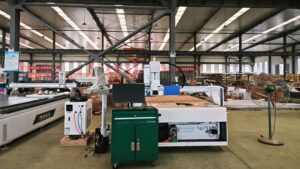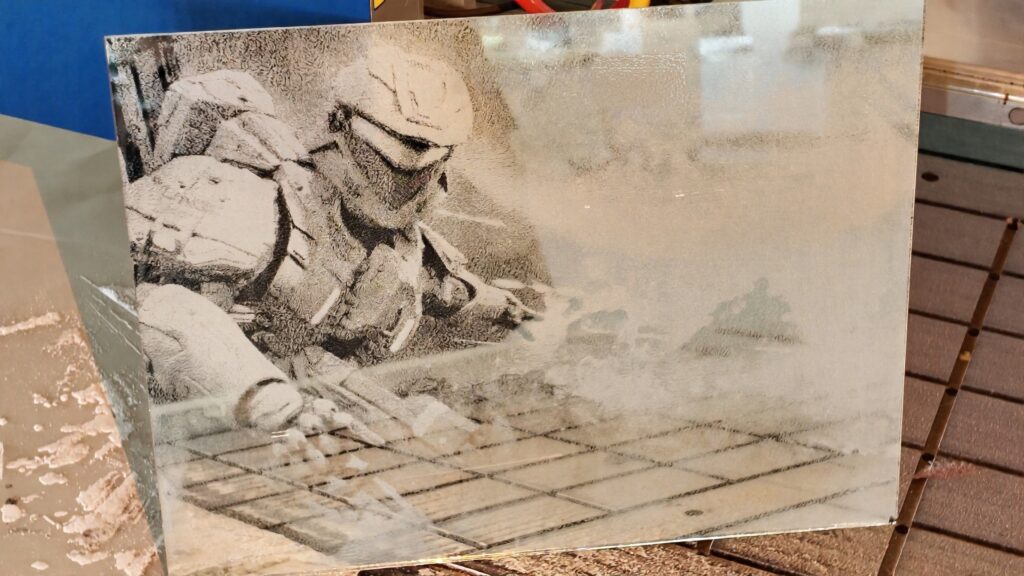Insufficient workbench flatness is just one of the issues; a systematic solution is required to resolve them completely.
As a responsible person or production manager in a glass manufacturing enterprise, have you ever encountered such frustrations in the laser sandblasting process: expected exquisite patterns end up with positioning deviations, partial blurring, or even complete deformation after actual processing? These troublesome precision issues not only result in high material waste but also drag down overall production efficiency.
Many people first attribute the problem to the levelness of the equipment workbench. This is indeed one of the common causes, but by no means the only one. To thoroughly solve laser sandblasting precision issues, a more systematic and professional approach must be adopted for investigation.
This article will provide an in-depth analysis of the three major factors affecting laser sandblasting precision and offer practical avoidance methods.

Core Cause 1: Mechanical Structural Defects (Workbench Flatness Issues)
As you have encountered, the workbench (Table Surface) serves as the reference plane for glass substrates. Insufficient flatness directly disrupts the ideal distance between the processed object and the laser focal length.
Problem Manifestation: Inconsistent engraving depths at different positions within the processing plane, with clear focus areas but blurred and weak areas away from the focus. When glass sheets warp slightly due to an uneven workbench, the size and energy density of the laser spot’s actual impact point change, leading to errors.
Underlying Causes:
- The workbench surface itself has errors and insufficient hardness.
- Long-term load-bearing deformation: Over years of carrying heavy glass, the workbench may undergo subtle deformations invisible to the naked eye.
- Initial manufacturing defects: Low-quality equipment lacks high-precision gantry milling and stress relief treatments before leaving the factory.
- External force impacts: Collisions during production or improper maintenance cause dents or deformations on the workbench.
Avoidance and Solutions:
- Regular inspection and calibration:Use professional levels, dial indicators, or laser interferometers to periodically check workbench flatness and establish a maintenance schedule.
- Invest in high-quality equipment: Our PVC workbench has an error margin of less than 0.3mm.
Core Culprit 2: Laser System and Guide Rail Positioning Accuracy
If the mechanical foundation is sound, the issue may lie in the “execution system” itself.
Problem Manifestation: The entire pattern exhibits regular offsets, repetitive errors, or dimensional inaccuracies.
Underlying Causes:
- Wear of guide rails and transmission systems: High-precision linear guideways and ball screws driving the laser head may develop backlash if worn or inadequately lubricated, leading to positioning inaccuracies.
- Laser generator performance degradation: Unstable laser power or dust on focusing lenses affects effective processing energy.
Avoidance and Solutions:
- Strictly implement preventive maintenance: Regularly clean guide rails, apply specified lubricants, and tighten transmission components.
Perform backlash compensation: Modern CNC systems offer backlash compensation features, requiring periodic testing and parameter input by professional engineers for software compensation.
Monitor laser output: Regularly check laser output with a power meter and keep focusing optical lenses clean.
Core Culprit 3: Software Parameters and Improper Operating Techniques.
The importance of “soft” factors is often underestimated. Unreasonable parameter settings are equivalent to letting a high-performance machine “fly blind.”
Problem Manifestation: Loss of pattern details, sharp corners turning rounded, incomplete cuts, or overburning.
Underlying Causes:
- Mismatched processing parameters: Failure to adjust the optimal combination of laser power, speed, frequency, and pass count for glass of varying thicknesses and materials.
- Graphic design and path planning issues: Flaws in the design itself or poor software path generation algorithms.
Avoidance and Solutions:
- Establish a standardized parameter database: Create and lock optimal processing parameters for different product types to prevent arbitrary changes by operators.
- Enhance operator training: Ensure operators deeply understand the impact of parameters on results, not just how to press buttons.
- Choose intelligent control systems: Upgrade or select advanced control systems with intelligent parameter recommendations and error compensation algorithms to offset minor hardware errors at the software level.
Conclusion: Systematic Thinking Is Key to Problem-Solving
The causes of laser sandblasting precision errors are often multi-dimensional; rarely do they stem from a single source. A thorough precision calibration must encompass a full-chain inspection from mechanical foundations (workbench, guide rails) → power core (laser generator) → control brain (software, parameters).
If you are troubled by such issues and unsure of the root cause, we are willing to assist you.
Our company specializes in high-precision glass machinery manufacturing, offering not only laser sandblasting equipment with ultra-high flatness workbenches and top-tier transmission systems upon delivery but also professional precision testing and repair solutions for existing equipment.
Contact us now for a free initial technical consultation, and let us help you identify the root cause and restore perfect processing precision.


